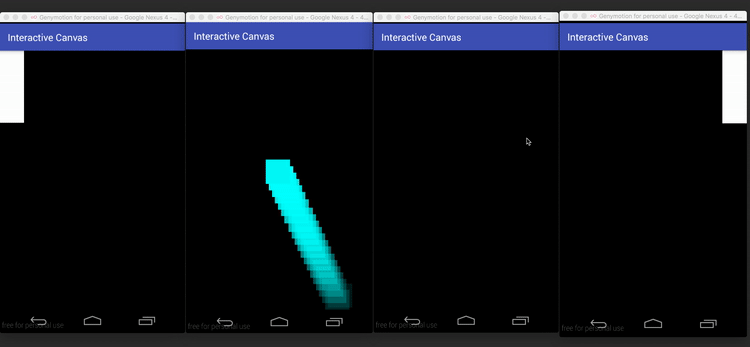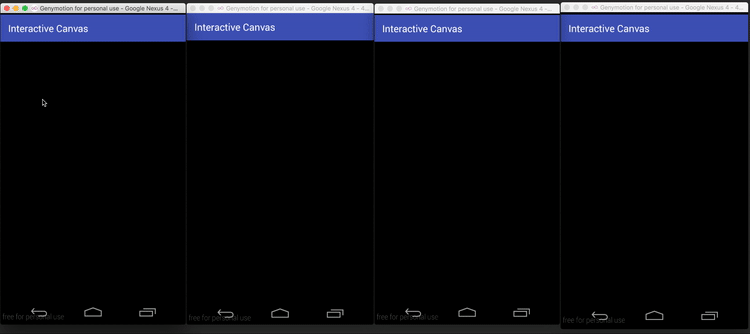InteractiveCanvas
The library distributes canvas animation over set of devices.
How it works
The library is based on pretty dumb method: Picture class has writeToStream and createFromStream methods which serializes and deserializes Picture object respectively. After serialization byte array sends to a client device as UDP packet. On a client device the packet is deserialized back into Picture object and finaly rendered on a Canvas. That's all.
Advantages
- It's quite easy to distribute regular
Canvasanimation over almost any number of devices. You could develop and test your game (or just animation) on one device and then launch it on a set ofAndroid TV-setsfor instance. Picturerepresents a frame of animation. Size of serializedPictureobject is relatively small: could be 100 to 300 bytes - it depends on comlexity of your animation. So there is no need to have wide bandwidth to send 30 or 60 packets(frames) per second.- Serialization of frames and game logic execution could be performed on a separate device or even on a separate computer(with
Androidemulator/virtual machine). It could be useful when you need to perform heavy computations to preparePictureframes or handle lots of usersMotionEvents.
Limitations
- The library uses deprecated methods. So some day it could just stop working. Though it could be used for some interactive installations or presentations where you have particular set of devices.
- Initally the libray was designed for relatively simple animation. Complex animation could overflow maximum size of
udppacket. In this case you could either try to compress frames or send frames overtcp.
Usage
- Host side should extend
InteractiveCanvas.javaand overrideonDrawmethod:
@Override protected void onDraw(Canvas canvas) {
//...draw on canvas super.onDraw(canvas);
// at the end of animation `super` method must be called
}
- Then your canvas shoud be configured with array of
Screens.Screenrepresents client device where animation should be displayed.
hostCanvas.config(screens, PICTURES_PORT, TOUCH_EVENTS_PORT);
hostCanvas.start();
- Client should create
PictureReceviverinstance and configure it withReceiverViewinstance:
pictureReceiver = new PictureReceiver(clientId);
pictureReceiver.config(PICTURES_PORT, HOST_ADDRESS, TOUCH_EVENTS_PORT);
pictureReceiver.setReceiverView(receiverView);
pictureReceiver.start();
Samples
Ther're two samples: PingPongActivity and MirrorActivity. Both of the classes contain similar two static fields:
private static final InetAddress HOST_ADDRESS = Utils.getAddress("192.168.56.101");
private static final InetAddress[] CLIENT_ADDRESSES = new InetAddress[]{
HOST_ADDRESS,
Utils.getAddress("192.168.56.102"),
Utils.getAddress("192.168.56.103"),
Utils.getAddress("192.168.56.104")
}
;Change this ip adresses to id adresses of your devices and launch app on all devices.
Download
repositories {
maven {
url "https://jitpack.io"
}
}
//... dependencies {
//...
compile 'com.github.elevenetc:interactivecanvas:0.9.0'
}

